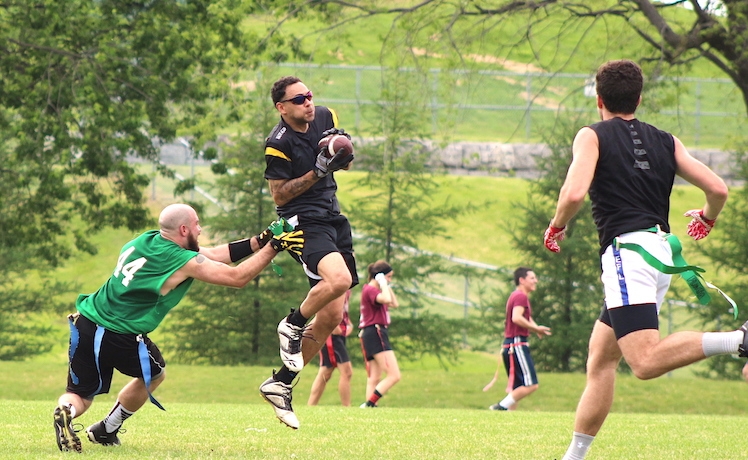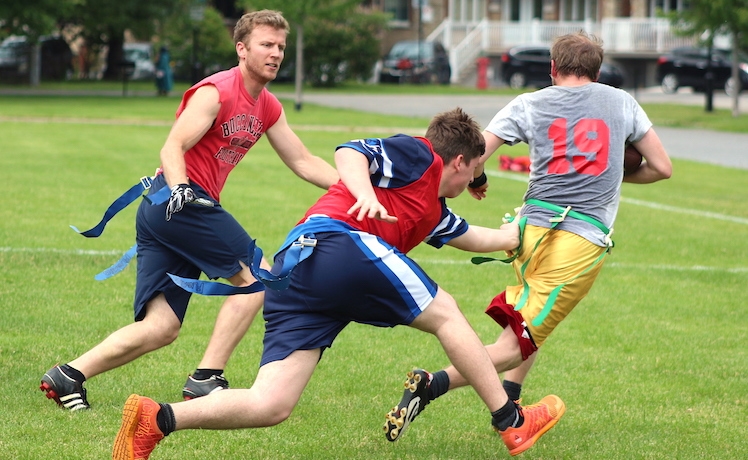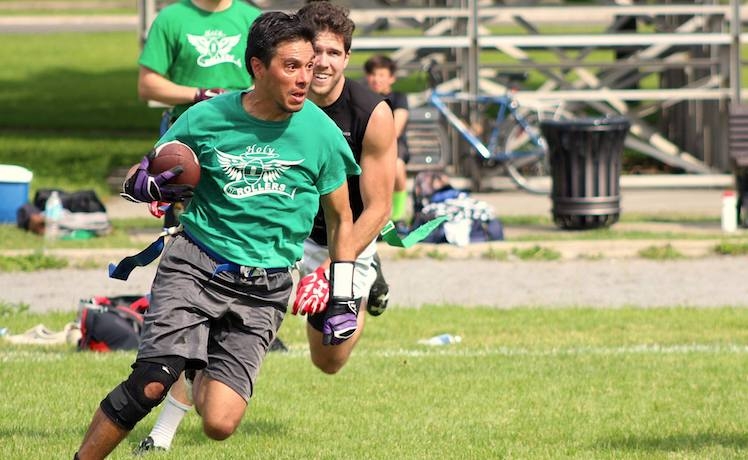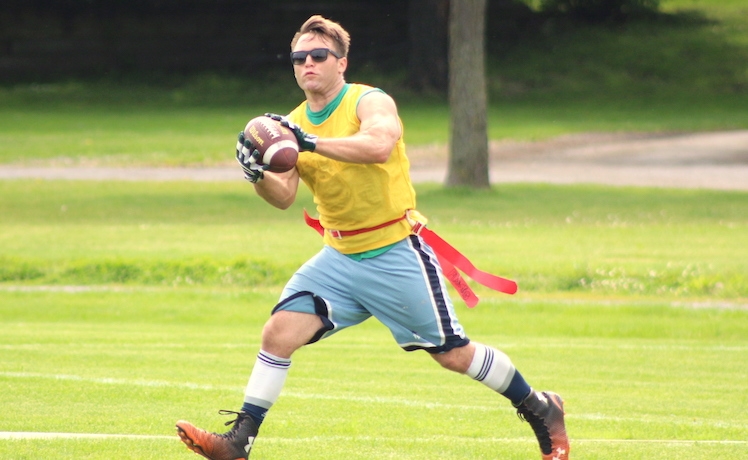
MFL Week 9 In Review
Semaine 9
Quelle semaine ce fût! Au parc Villeray qui est devenu le finalement le parc Étienne-Desmarteau, le KOLB à démontrer sa supériorité face à la Locomotion en l’apportant 56 à 12, dans un match à couper le souffle, la Revolucion a vaincu les Gros Coqs 26 à 25 en prolongation et les Brown Machines l’ont facilement emporté sur leur match retour contre les Sooners 45. Mais voyez maintenant les autres résultats un peu plus en détails, voici tout ce qui s’est passé au parc Ignace-Bourget!
Division 1
Deep Threats (DT) vs Player Haters (PH)
Le dernier match entre les deux équipes qui avait eu lieu à la semaine 2 c’était soldé par une victoire des PH 27 à 6. Ce samedi, il aura fallu attendre après 15 minutes pour voir le premier touché alors que J-C Blais a rejoint Jonathan Svetna sur 25 verges. Les DT en avance, Antoine Kraft-Cloutier les intercepta pour retourner ce ballon en un touché. La demie c’est terminé sur le score de 7à7 alors que les défensives ont impressionnés, Antoine Kraft-Cloutier a eu un sack sur J-C Blais qui lui a remis la monnaie de sa pièce peu de temps après.
Les DT ont débuté à l’attaque sur cette deuxième demie mais Antoine KC les intercepta pour rejoindre Mathieu Lacharité sur 11 verges donnant un touché le jeu suivant. Quelques temps plus tard, le QB des PH couru lui-même sur 17 verges pour un autre touché puis 30 secondes plus tard, après avoir intercepté les DT, il rejoignit Mathieu Lacharité pour un autre touché. Les DT ont finalement répliqué alors que J-C Blais rejoignit Jonathan Svetna pour son deuxième touché. Le match c’est terminé 27 à 13 pour les PH, mais si les DT avaient attrapés toutes les passes, ce match aurait été beaucoup plus serré.
Les Deep Threats joueront contre les OG Panthers et même si Deep Threats ne participera pas aux séries, une victoire avant de terminer la saison ferait le plus grand bien. Les Player Haters affronteront le puissant KOLB et auront à sortir tous leurs talents s’ils veulent l’emporter.
Krakens vs Holy Trollers (HT)
Avec plusieurs absents mais de bons substituts, les HT ont débutés à l’attaque mais n’ont rien produit, les Krakens par contre, s’en sont donnés à cœur joie. Robert Prudhomme à rejoint Francisco Ballesteros sur 26 verges pour un premier touché. Chris donna la réplique en rejoignant Math sur 45 verges pour prendre les devants avec un converti réussi. Après une belle montée, le QB des Krakens trouva Kevin Smuda dans la zone payante pour reprendre l’avance. La demie loin d’être finit, le duo Chris-Math des HT inscrivit deux autres touchés tout comme les Krakens, entre autre grâce à un touché et des attrapés spectaculaires de Silvio Ciarrochi, joueur de la semaine.
Les Krakens ont débuté à l’attaque en deuxième demie, menant déjà par un touché (25 à 19), Robert Prudhomme rejoignit Francisco Ballesteros pour ajouter 6 points. En seulement 3 passes, les HT marquèrent un autre touché du duo Chris-Math. Intraitable, les Krakens ont réussi une fois de plus à marquer sur le duo Prudhomme – Ciarrocchi. Après une dernière tentative qui fût infructeuse pour les HT, Robert Prudhomme inscrivit un dernier touché en rejoignant pour sa fête : Stuart Lambon sur une distance de 45 verges.
Après leur victoire de 44 à 26, les Krakens s’attaqueront au Gros Coqs samedi prochain, le prélude d’un match époustouflant. De l’autre côté, le match de la semaine, les Holy Trollers joueront contre les Outlaws, le green machine avait perdu leur dernier match contre eux, à la semaine 1, par la marque de 31 à 6.
OG Panthers (OGP) vs Outlaws
Le dernier match de la journée semblait tout désigné pour être une rencontre de gros calibre et ce fut le cas. Dès leur première possession, les OGP ont inscrits un touché alors que Charles Duchesne trouva Charles Deslauniers dans la zone payante. Les Outlaws ont alors rencontrer une défense puissante et après un sack de Terry Babalis, ils ont dû dégager, le jeu suivant, Charles Duchesne rejoignit Louis-Mathieu Dufour sur un « slant » (courte passe rapide) qui se transforma en un touché de 45 verges. Après un 4ème essaie risqué et manqué des Outlaws, les OGP ont poursuivis la progression en marquant un 3ème touché d’avance. Les Outlaws ont finalement marqué leur premier touché lorsque Stephen Persaud rejoignit Jie OuYang sur 10 verges. Foti Evangelista et Vincent Blondin ont eu des interceptions pour que finalement ce dernier capte une passe de touché de Stephen Persaud terminant la demie 18 à 12.
Le début de la deuxième mi-temps fût un sack et un touché de Terry Babalis. C’est à la moitié de cette demie que les Outlaws ont finalment ouvert la machine. Stephen Persaud lança une passe de 16 verges à Shyanne Stewart pour un touché, puis un autre à Jie OuYang prenant ainsi les devants pour la première fois du match. De plus, la défensive des Outlaws n’accorda plus aucun point. Le duel c’est terminé 26 à 15 en faveur des Outlaws.
Les Outlaws tenteront de garder le premier rang dans l’ouest alors qu’ils joueront contre les Holy Trollers dans le match de la semaine. Les OG Panthers rencontreront Deep Threats et même s’ils sont assurés d’être en série, ils tenteront une victoire afin d’avoir l’avantage du terrain.
En attendant la semaine 10
Semaine spectaculaire veut aussi dire jeux sensationnelles qui incluent par la même occasion : des joueurs hors normes! Voici ceux qui auraient très bien pu être joueur de la semaine et qui à l’approche constantes des séries, continueront de se surpasser!
Division 1
Quentin Pha – KOLB avec 4 réceptions pour 69 verges, 2 touchés, 2 plaqués et 3 interceptions dont une pour 1 touché.
Charles Desaulniers – OG Panthers avec 6 réceptions pour 29 verges, 1 touché et 10 plaqués.
Robert Prudhomme – Krakens avec 260 verges par la passe, 7 touchés aériens, 20 verges au sol et 1 plaqué.
Division 2
Félix Desbiens-Gravel – Mr. Meeseeks avec 255 verges par la passe, 6 touchés aériens, 2 plaqués et 1 interception.
Yuri Baussan – Old School avec 5 réceptions pour 94 verges, 1 touché, 2 plaqués et 1 sack.
André-Philippe Bertrand – Iron Wolves avec 11 réceptions pour 84 verges, 3 touchés, 3 plaqués et 1 interception.




